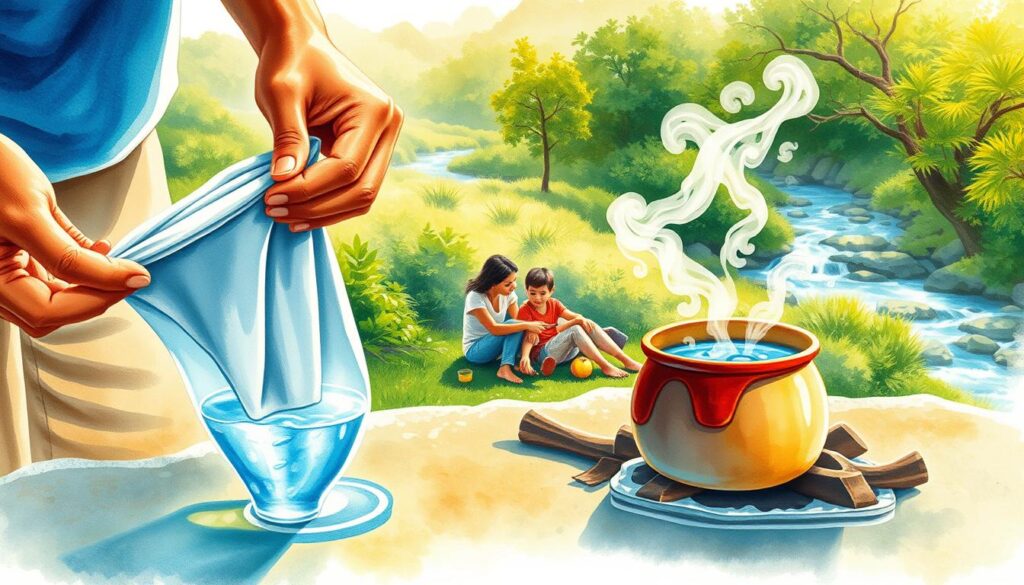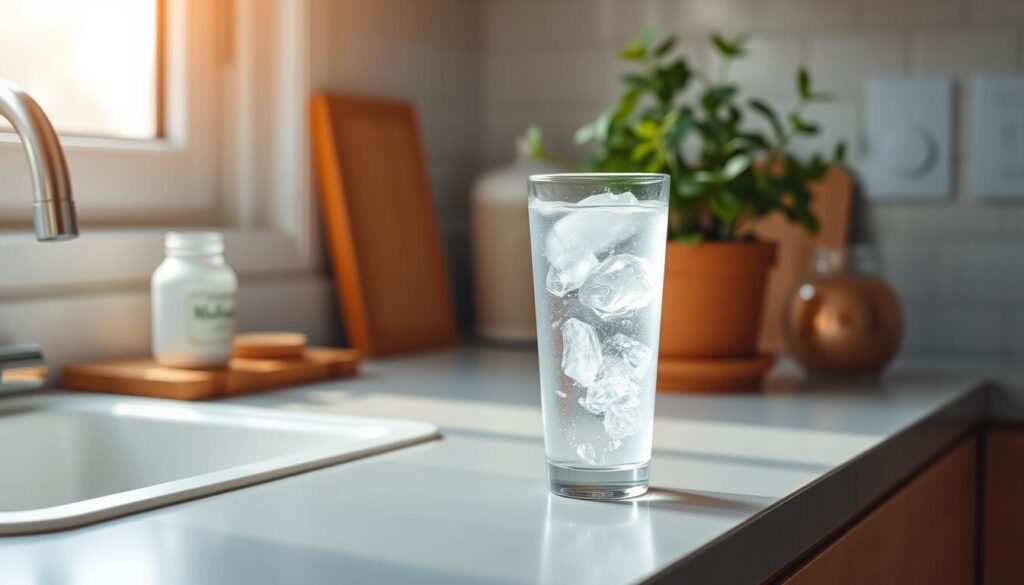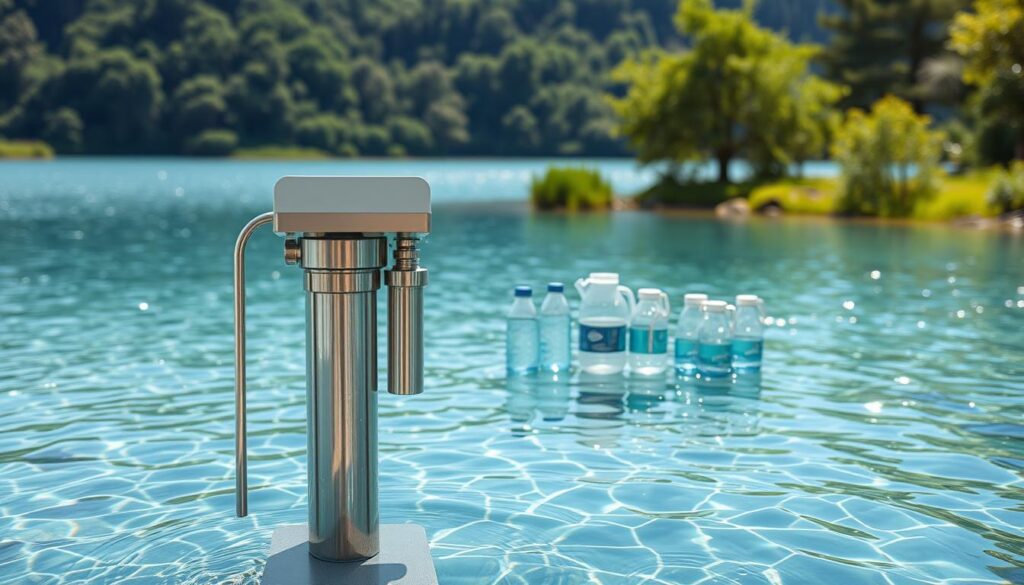My journey to learn about waterborne illnesses was eye-opening. It taught me the importance of staying safe. I found that knowledge, vigilance, and simple practices are key.
I’ve learned how to lower the risk of getting these illnesses. By following a few easy habits, you can greatly reduce your chance of getting sick. This keeps you healthy and safe.
Key Takeaways
- Understand the risks associated with contaminated water.
- Learn simple practices to minimize exposure.
- Adopt habits that promote health and safety.
- Stay informed about waterborne disease prevention methods.
- Apply effective strategies to avoid waterborne illnesses.
Understanding Waterborne Diseases
Learning to avoid waterborne diseases is key. These illnesses come from tiny pathogens in contaminated water. It’s vital to know how they work.
What Are Waterborne Diseases?
Waterborne diseases happen when we drink or touch contaminated water. They are caused by bacteria, viruses, and parasites. These pathogens can spread diseases to many people.
Common Pathogens Involved
Many pathogens cause waterborne diseases. Cryptosporidium, Giardia, and Leptospira are common ones. Each can lead to different symptoms.
| Pathogen | Disease Caused | Common Symptoms |
|---|---|---|
| Cryptosporidium | Cryptosporidiosis | Diarrhea, stomach cramps, fever |
| Giardia | Giardiasis | Diarrhea, gas, stomach cramps |
| Leptospira | Leptospirosis | High fever, headache, muscle pain |
Impact on Public Health
Waterborne diseases have a big impact on public health. The World Health Organization (WHO) says they cause many illnesses and deaths each year. Children, the elderly, and those with weak immune systems are most at risk.
It’s important to understand waterborne diseases to prevent and treat them. By knowing the risks and taking action, we can lower the number of cases.
Recognizing Sources of Contamination
Finding out where contamination comes from is vital to stay healthy. Water can get dirty from many places. Knowing these helps keep everyone safe.
Contaminated Water Supplies
Dirty water sources are a big problem. Germs can grow in pipes, making people sick. For example, legionella bacteria can cause Legionnaires’ disease. We need to fix pipes and treat water to stop this.
Poor Sanitation Practices
Bad waste handling also makes water dirty. Not disposing of waste right can pollute water. For instance, improperly treated sewage can spread diseases. We must clean up waste and teach people to stay clean.
- Implementing proper waste disposal methods
- Using effective sewage treatment systems
- Promoting public awareness about hygiene practices
Flooding and Natural Disasters
Natural disasters can really mess up water. Floods bring in dirt, sewage, and chemicals. This is very dangerous. We need to watch out for these dangers and have plans ready.
- Monitoring water quality after natural disasters
- Implementing emergency water treatment measures
- Providing public education on safe water practices during such events
The Importance of Clean Water
Clean water is vital for our daily lives. It’s needed for drinking, cooking, personal hygiene, and cleaning. Without it, our health and well-being suffer.
Benefits of Drinking Safe Water
Drinking safe water keeps us healthy. Clean drinking water stops waterborne diseases. Health experts say bad water can cause many illnesses, from mild to severe.
Drinking water hygiene is key to public health. Clean drinking water lowers disease risks. This is very important for kids, the elderly, and those with weak immune systems.
“Access to safe drinking water is a fundamental human right, essential for maintaining health and well-being.”
Water in Daily Life
Water is not just for drinking. It’s also vital for cooking, cleaning, and personal hygiene. For example, washing hands with clean water stops illnesses from spreading.
| Daily Activity | Importance of Clean Water |
|---|---|
| Drinking | Prevents waterborne diseases |
| Cooking | Ensures food safety and hygiene |
| Personal Hygiene | Prevents the spread of illnesses |
Clean Water’s Role in Disease Prevention
Clean water initiatives are key to stopping waterborne diseases. Clean water reduces diseases like cholera and typhoid. It also helps keep us hygienic, which fights off diseases.
In conclusion, clean water is very important. It’s key for our health, daily tasks, and overall well-being. By focusing on clean water initiatives and keeping drinking water hygiene high, we make our environment healthier for everyone.
Personal Hygiene Practices
Good hygiene practices are key to avoiding waterborne diseases. Simple habits can greatly lower the risk of getting sick. By following these practices, you can stay healthy.
Handwashing Techniques
Proper handwashing is a must. Washing hands with soap and clean water for 20 seconds is essential. Do this after using the bathroom and before eating. It helps stop the spread of germs.
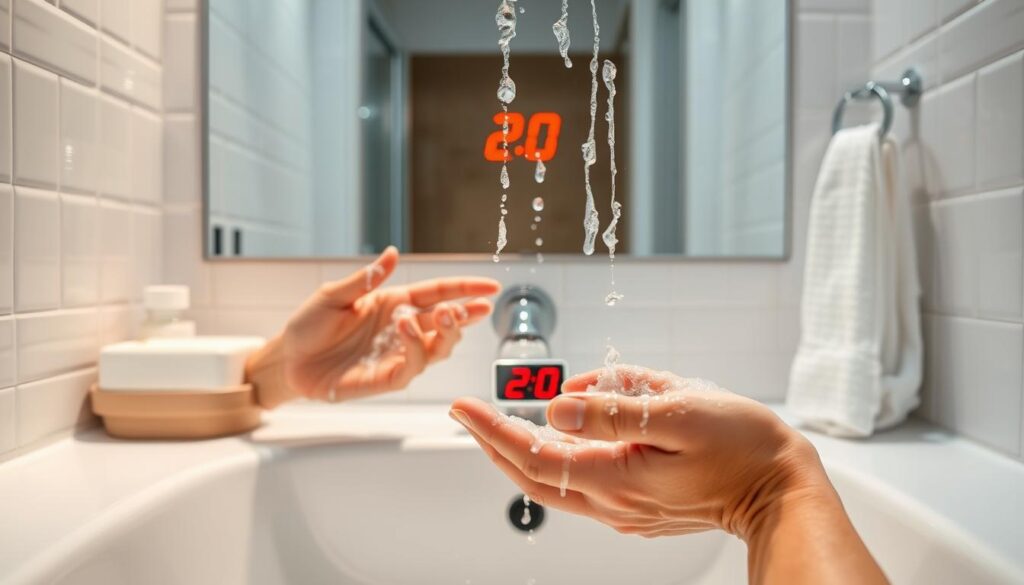
Importance of Clean Surfaces
Clean surfaces are also important. Regularly disinfect surfaces that touch food or are often touched. This is key in kitchens and bathrooms to stop germs.
Safe Food Handling
Safe food handling is vital. This means proper storage, handling, and cooking of food. Cooking food well and storing it right can kill harmful germs. I’m careful with food to avoid contamination.
- Always wash fruits and vegetables under clean running water before consumption.
- Use separate cutting boards for raw meat, poultry, and vegetables to prevent cross-contamination.
- Cook food to the recommended internal temperature to ensure that pathogens are killed.
Home Water Filtration Solutions
Using a water filtration system is a great way to make sure your drinking water is safe at home. I learned this after facing the dangers of waterborne diseases. So, I looked into different home water filtration options to keep myself healthy.
Types of Water Filters
There are many types of water filters for homes, each with its own benefits. Some common ones are:
- Activated carbon filters, which remove chlorine, taste, and odor from water.
- Reverse osmosis filters, which use a semipermeable membrane to filter out many contaminants, including dissolved solids.
- Ultraviolet (UV) filters, which kill bacteria, viruses, and other microorganisms with UV light.
Each filter type has its own strengths and is best for different needs and water conditions.
Benefits of Installing a Filter
Having a home water filtration system brings many advantages, including:
- Improved taste and odor of your drinking water.
- Reduced risk of getting waterborne diseases.
- Cost-effective compared to buying bottled water.
- Environmental benefits by cutting down on plastic waste from bottled water.
By getting a water filtration system, I’ve not only made my drinking water better. I’ve also helped the environment by using less plastic.
Regular Maintenance Tips
To keep your home water filtration system working well, regular care is key. Here are some tips:
- Replace filter cartridges as the manufacturer suggests.
- Clean and sanitize the system now and then.
- Keep an eye on your water quality to spot any problems.
By sticking to these maintenance tips, I’ve kept my water filtration system in top shape. And I’ve enjoyed safe drinking water ever after.
Boiling Water for Safety
Boiling water is a simple way to kill harmful germs. It’s a method that has been around for centuries. I’ve seen how important clean water is, and boiling is a key part of that.
Why Boiling is Effective
Boiling water kills bacteria, viruses, and parasites. This makes water safe to drink. The heat from boiling changes the proteins in these germs, stopping them from causing sickness.
“Boiling water is a simple and effective method for killing pathogens.” This step is key to making water safe. Boiling water lowers the risk of getting sick from drinking it.
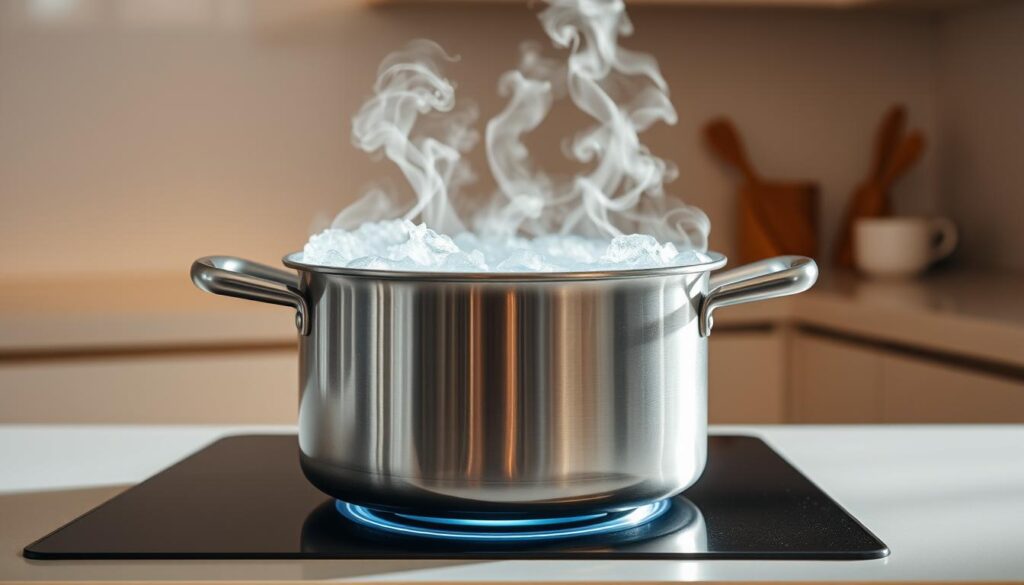
How Long to Boil Water
How long you boil water matters. Boiling for 1-3 minutes usually kills most germs. But, the exact time can change based on altitude and the type of germs.
- At sea level, 1 minute of boiling is typically sufficient.
- At higher altitudes, a longer boiling time may be necessary due to lower atmospheric pressure.
When to Boil Water
Boiling water is needed in many situations. This includes during outbreaks, when the water is contaminated, or after natural disasters. It’s also wise when traveling to places with questionable water.
When traveling, it’s best to boil water before drinking. This helps avoid getting sick from waterborne illnesses.
“In many areas, boiling water is a necessary precaution to prevent waterborne diseases.”
Educating My Community
Learning about waterborne diseases made me want to share this info with my community. Teaching others has helped stop these diseases from spreading. It also brought us closer together.
Sharing Knowledge with Neighbors
I began by teaching my neighbors about waterborne diseases. I told them how contaminated water can be harmful. I also showed them how to wash hands properly and use safe drinking water.
“The key to preventing waterborne diseases lies in education and community awareness.” By sharing what I know, I’ve helped my neighbors protect their health.
Organizing Local Workshops
I then organized workshops to teach more about preventing waterborne diseases. We talked about how to spot bad water, the importance of sanitation, and how to purify water at home.
Partnering with Health Organizations
I teamed up with local health groups to educate our community. This partnership helped us share more information and resources. It boosted our clean water initiatives.
“Community engagement and education are key in fighting waterborne diseases. Working with health organizations makes our efforts stronger and safer for everyone.”
This partnership made our message stronger. It also made more people want to join our cause.
Through education and teamwork, we’ve made a big difference in waterborne disease control. By keeping up the good work, I’m sure we’ll keep making progress.
Traveling Safely to Prevent Waterborne Diseases
I’ve learned that knowing about local water quality is key to staying safe while traveling. Exploring new places is exciting, but it’s also important to watch out for waterborne diseases. Being informed and taking precautions can help you avoid getting sick.
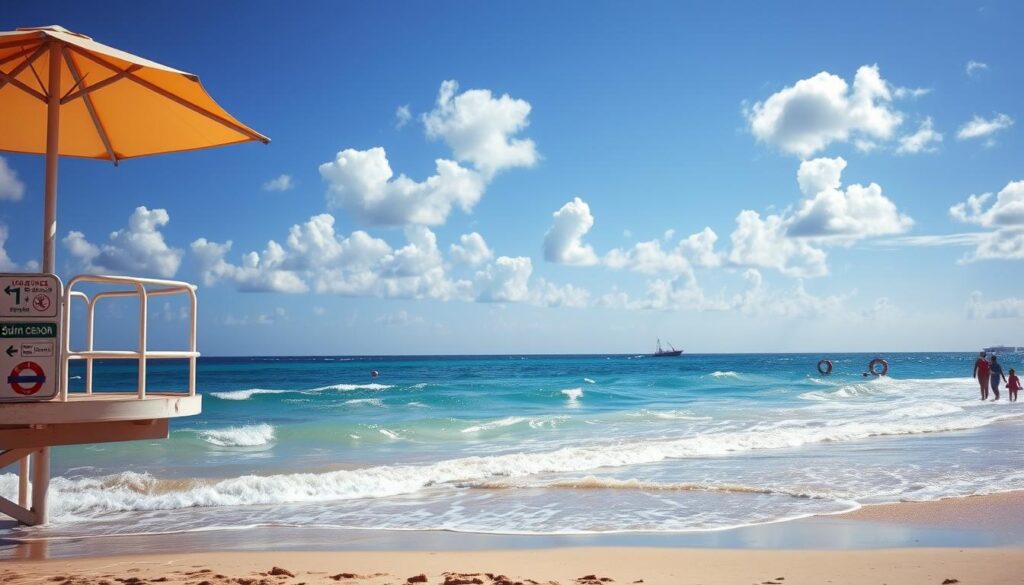
Drinking Water Precautions Abroad
Being careful with drinking water is a must when traveling. In many places, tap water isn’t safe to drink. Even in some countries you might visit, water quality can vary. Always drink bottled or filtered water to stay safe.
Additional precautions include avoiding ice in drinks and being careful with drinks that might have tap water in them.
Awareness of Local Water Quality
Knowing about the water quality where you’re going is very important. Look up the water quality of your destination before you go. Governments and health groups often give travel advisories with water safety info. This helps you make smart choices about what water to drink and how to stay clean.
- Check local health advisories before traveling.
- Understand the sources of water in your destination.
- Be aware of any ongoing water quality issues.
Packaging Safe Food
It’s not just water that can be a risk when traveling; contaminated food can also cause waterborne diseases. Safe food handling practices are key. Avoid raw or undercooked foods, like seafood and meat, as they can be contaminated. Choose fruits and veggies that can be peeled or have been washed well.
When eating out, pick places known for their cleanliness. Paying attention to how food is made and stored can lower your risk of getting sick.
The Role of Vaccinations
Preventing waterborne diseases needs a mix of methods, and vaccinations play a big part. Many focus on treating water and keeping things clean. But vaccines add extra protection against some waterborne germs.
The Centers for Disease Control and Prevention (CDC) says vaccines are key for diseases like typhoid and cholera. They’re vital for those traveling to high-risk areas or with certain jobs. Studies show vaccines can greatly lower the risk of these diseases (reliable sources confirm this).
Vaccines for Preventable Waterborne Diseases
There are vaccines for waterborne diseases. For instance, the typhoid vaccine is a must for those going to places with bad sanitation. The cholera vaccine also helps against cholera, a disease linked to dirty water and food.
Staying Up-to-Date with Immunizations
Keeping up with vaccinations is key to fighting waterborne diseases. It means following your doctor’s advice and knowing about any extra shots. Regular doctor visits help make sure your shots are current.
Consulting Healthcare Providers
Talking to a doctor is important to figure out what vaccines you need. They can give advice based on your health and plans. They make sure vaccines are given safely and right.
By mixing vaccines with safe water and hygiene, you can lower your risk of waterborne diseases a lot.
Understanding Water Quality Reports
Learning about waterborne diseases made me realize how important water quality reports are. These reports help spot health risks from contaminated water.
Water quality reports give detailed info on contaminants in the water. This includes bacteria, viruses, heavy metals, and pollutants.
How to Read Water Quality Reports
At first, reading water quality reports might seem hard. But it’s key for knowing your water’s safety. The reports list contaminants found, their levels, and compare them to safe limits.
For example, a table in a report might look like this:
| Contaminant | Detected Level | Maximum Allowable Limit |
|---|---|---|
| Total Coliform Bacteria | 0 CFU/100mL | 0 CFU/100mL |
| Lead | 0.005 mg/L | 0.015 mg/L |
| Chlorine | 1.2 mg/L | 4 mg/L |
Identifying Unsafe Levels
It’s key to know when contaminant levels are too high. If a contaminant’s level is above the safe limit, it’s a health risk.
Watch out for these common contaminants:
- E. coli and other coliform bacteria
- Heavy metals like lead and mercury
- Chemicals and pesticides
Taking Action When Issues Arise
If a report shows unsafe contaminant levels, take action. You might use different water sources, get a home filter, or push for better water systems.
Understanding and acting on water quality reports can lower disease risks. It’s a step towards keeping yourself and your community safe.
Monitoring Waterborne Disease Outbreaks
Keeping track of waterborne disease outbreaks is key for public health. It’s important to stay updated and know how to act fast.
Reliable Sources for Updates
It’s vital to trust sources that give updates on waterborne disease outbreaks. Some top sources include:
- Centers for Disease Control and Prevention (CDC)
- World Health Organization (WHO)
- Local health department websites
These groups send out alerts and detailed info on outbreaks. This helps people and communities stay safe.
Community Alert Systems
Community alert systems are key for fast info during outbreaks. They can include:
- Emergency alerts via text or email
- Public announcements on local media
- Social media updates from health authorities
Joining these systems lets people get quick alerts. This helps them protect themselves and their families.
Reporting Illness to Authorities
Telling health officials about illnesses is a big step in controlling outbreaks. Reporting helps them:
This teamwork between the public and health officials is key for waterborne disease control.
Here’s a quick guide on how to monitor waterborne disease outbreaks:
| Action | Description | Benefit |
|---|---|---|
| Relying on credible sources | Staying updated with the latest info on outbreaks | Making informed choices |
| Participating in community alert systems | Getting quick alerts and updates | Acting fast during outbreaks |
| Reporting illnesses to authorities | Helping health officials track and stop outbreaks | Effective disease control |
Future Trends in Water Safety
Looking ahead, keeping water safe will need many different steps. New ways to clean water, like advanced filters and UV treatment, are key. These methods help stop diseases spread through water. Climate change might change how often these diseases happen, making them a big worry worldwide.
Emerging Technologies
Technology plays a big part in keeping water safe. Tools like real-time water quality checks and apps for water safety updates are important. The water filtration market is expected to grow a lot, reaching $14.7 billion by 2027. This growth will help us catch and deal with water disease outbreaks better.
Advocating for Change
It’s also important to push for better water laws. This helps make water safer for everyone. By supporting clean water efforts, we can make a big difference. Simple actions like boiling water can kill harmful germs, showing how important it is to keep learning about water safety.
For more on how climate change affects waterborne diseases, check this resource. For tips on staying safe from waterborne diseases, see this guide.
FAQ
What are waterborne diseases, and how are they caused?
Waterborne diseases come from drinking contaminated water or touching water with harmful germs. These germs can be in dirty water. Poor cleaning habits make things worse.
How can I identify if my water supply is contaminated?
Look at your water quality reports for signs of trouble. Check for visible dirt or use water testing kits. It’s key to test often, like after floods.
What are some effective methods for purifying water at home?
You can use home filters, boil water, or disinfect with tablets or UV light. Each method works well. But, you must keep them in good shape.
How often should I maintain my home water filtration system?
How often you need to clean it depends on the system and how much you use it. Usually, filters need a change every few months. Clean it as the maker says.
What are some safe practices for handling food and water while traveling?
Drink bottled or filtered water and avoid raw foods. Wash your hands often. Knowing the local water quality helps a lot.
How can I stay informed about waterborne disease outbreaks in my area?
Follow local health sites and sign up for alerts. Report any sicknesses. This helps stop outbreaks and keeps you updated.
What role does community education play in preventing waterborne diseases?
Teaching people how to stay safe is key. Share info, hold workshops, and work with health groups. This boosts water safety and hygiene.
How can I interpret water quality reports, and what should I look for?
Check for germs and if levels are safe. Knowing this helps spot problems and fix them.
What are some future trends in water safety that I should be aware of?
Look out for new ways to clean water and tech helping prevent diseases. Also, watch for clean water laws. Staying current helps you stay safe.
How can I contribute to preventing waterborne diseases in my community?
Keep clean, support water projects, and teach others about safety. Working together can really help.

